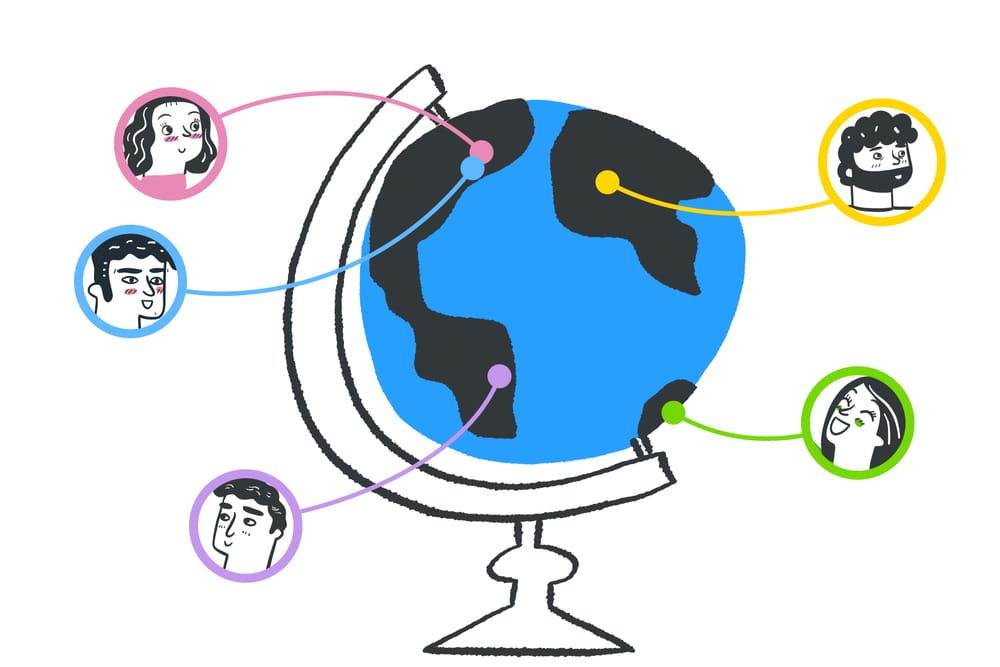As an engineering manager, I've witnessed firsthand the evolution of the workplace. One significant change in recent years is the rise of distributed teams.
This blog post will explore the concept of distributed teams, differentiate them from remote teams, and delve into their advantages, challenges, and management strategies.
A Comprehensive Guide to Distributed Teams
A distributed team is a group of individuals who work together from different geographical locations. Unlike traditional office-based teams, distributed teams rely heavily on digital communication and collaboration tools. They can span across cities, countries, and even continents, making them inherently diverse in terms of culture, time zones, and work environments.
Using the right technology and digital tools, a distributed office can be an efficient workplace. Distributed teams can streamline collaboration, communication, and project management. The use of team messaging platforms, both for individual and group interactions, along with video conferencing solutions, ensures that team members remain synchronized regardless of their geographic locations. This not only helps maintain a smooth flow of business operations but also fosters a connected work environment.
Difference Between a Distributed Team and a Remote Team
While "distributed team" and "remote team" are often used interchangeably, there's a subtle difference. Remote teams generally refer to employees who work outside the traditional office but are often located in the same country or time zone. On the other hand, distributed teams are inherently more global, with members spread across various geographical boundaries.
Pros and Cons of a Distributed Team
Pros:
- Access to Global Talent: Distributed teams allow companies to hire the best talent without geographical constraints.
- Increased Productivity: Flexibility in work hours can lead to increased productivity as team members work during their peak energy times.
- Diversity and Innovation: Diverse backgrounds bring in different perspectives, fostering innovation and creativity.
- Work-Life Balance: Flexibility can lead to a better work-life balance for team members.
- Cost Savings: Reduced overhead costs as there's less need for physical office space.
Cons:
- Communication Challenges: Different time zones and lack of face-to-face interaction can lead to communication hurdles.
- Cultural Differences: Varied cultural backgrounds might lead to misunderstandings or conflict.
- Tracking Progress: Monitoring work progress and ensuring consistency can be challenging in a distributed setup.
- Team Cohesion: Building a strong team culture and ensuring everyone feels included can be challenging.
- Security Concerns: Managing data security and privacy can be more complicated with team members spread across different regions.
Managing a Distributed Team
Effectively managing a distributed team involves several key strategies that address the unique challenges of this work setup:
Embrace Digital Tools
Use a range of digital tools for communication and collaboration. This includes project management tools like Asana or Jira, communication platforms like Slack or Microsoft Teams, and video conferencing tools like Zoom or Google Meet. For other cool tools, check out here.
Set Clear Goals and Expectations
Establish clear, measurable goals and communicate these expectations to ensure everyone is aligned. This helps in managing projects efficiently and keeps team members focused on their objectives.
Build a Trust-Based Culture
Foster a culture of trust and accountability. Trust your team to manage their time and tasks efficiently, and encourage them to take ownership of their work.
Regular and Inclusive Communication
Hold regular team meetings and one-on-one check-ins to stay updated on project progress and address any issues. Ensure that these meetings are scheduled at times that are as convenient as possible for all time zones.
Cultural Sensitivity and Inclusion
Embrace cultural diversity and promote inclusivity. Be aware of cultural differences and holidays, and respect them in your interactions and scheduling.
Encourage Informal Interactions
Create opportunities for informal chats and social interactions. This can be through virtual coffee breaks or non-work-related chat channels, which help in building team cohesion.
Invest in Team Building
Organize virtual team-building activities that can help in strengthening relationships and fostering a sense of belonging among team members.
Training and Development
Provide training to your team members to help them adapt to the distributed work environment and develop skills necessary for remote collaboration.
Performance Management
Adapt your performance management strategies to suit a distributed team setup. Set up regular performance reviews and provide constructive feedback.
Security Protocols
Implement robust security measures to protect sensitive data and ensure all team members are aware of and adhere to these protocols.
By incorporating these strategies, you can effectively manage a distributed team, ensuring productivity, collaboration, and a positive work environment despite the geographical distances. Remember, the key to success with distributed teams lies in effective communication, trust, and the use of the right tools to keep everyone connected and engaged.





